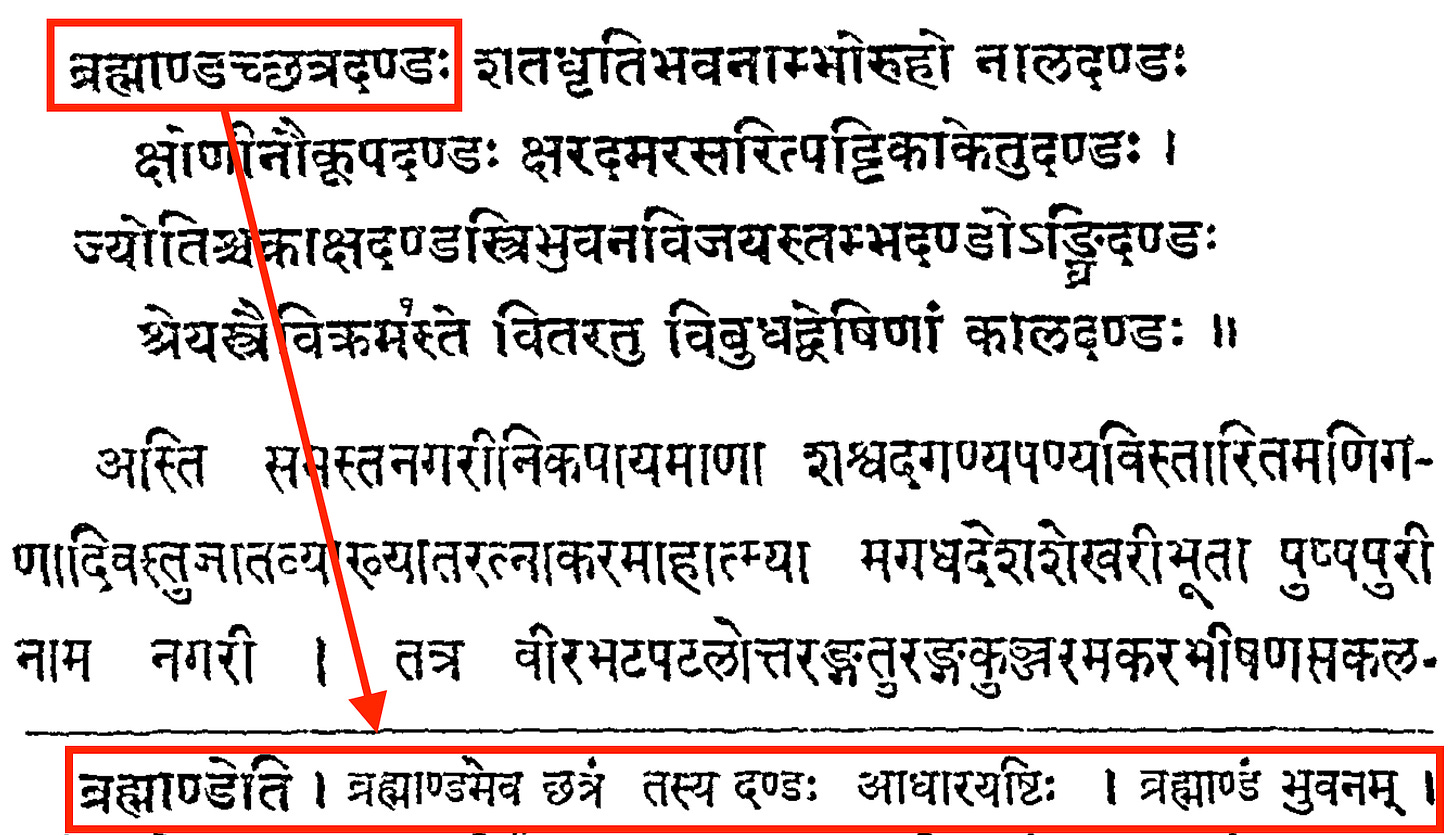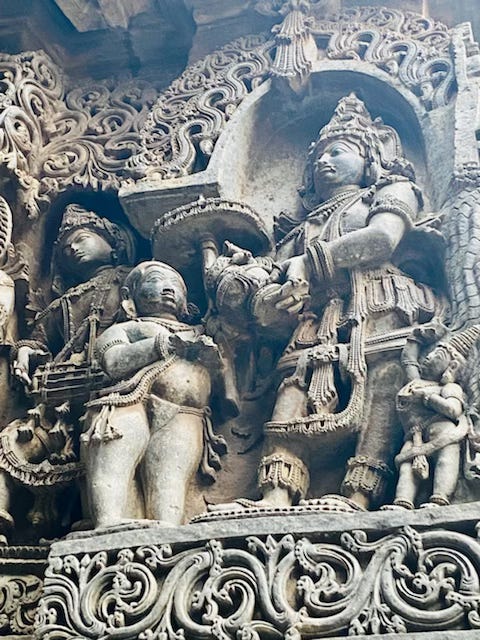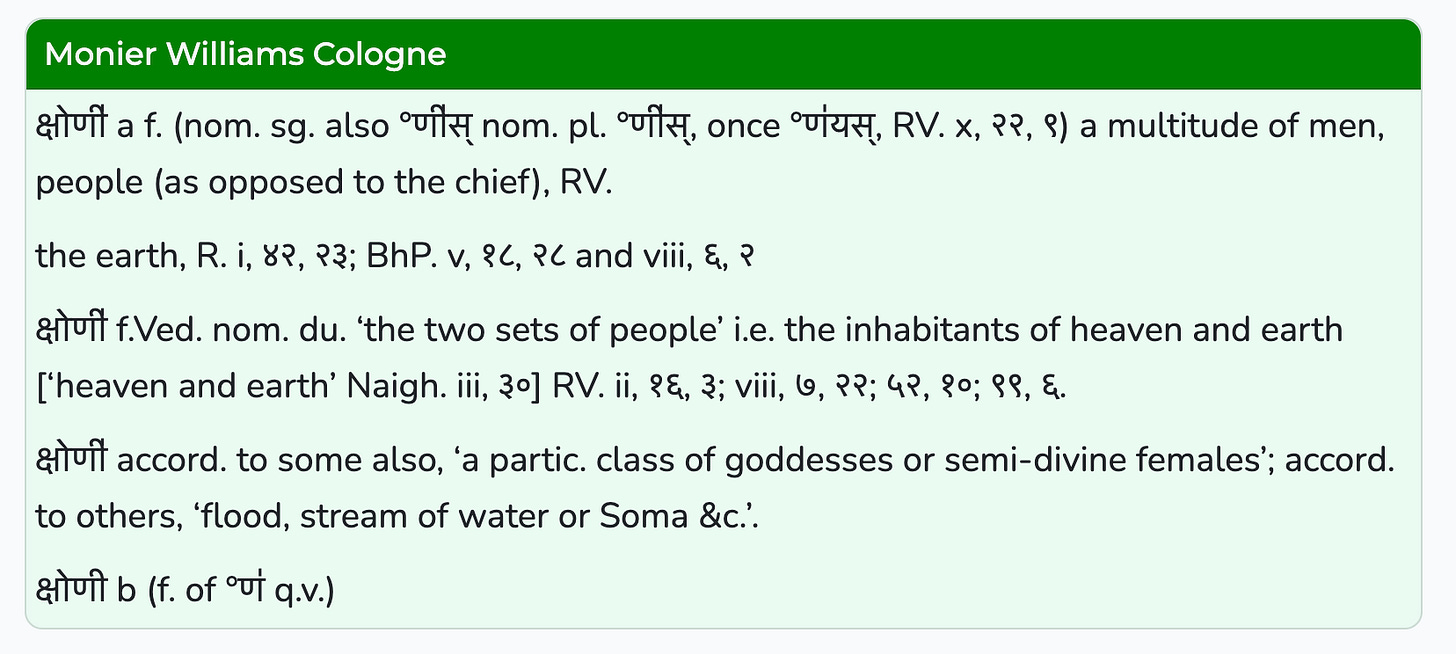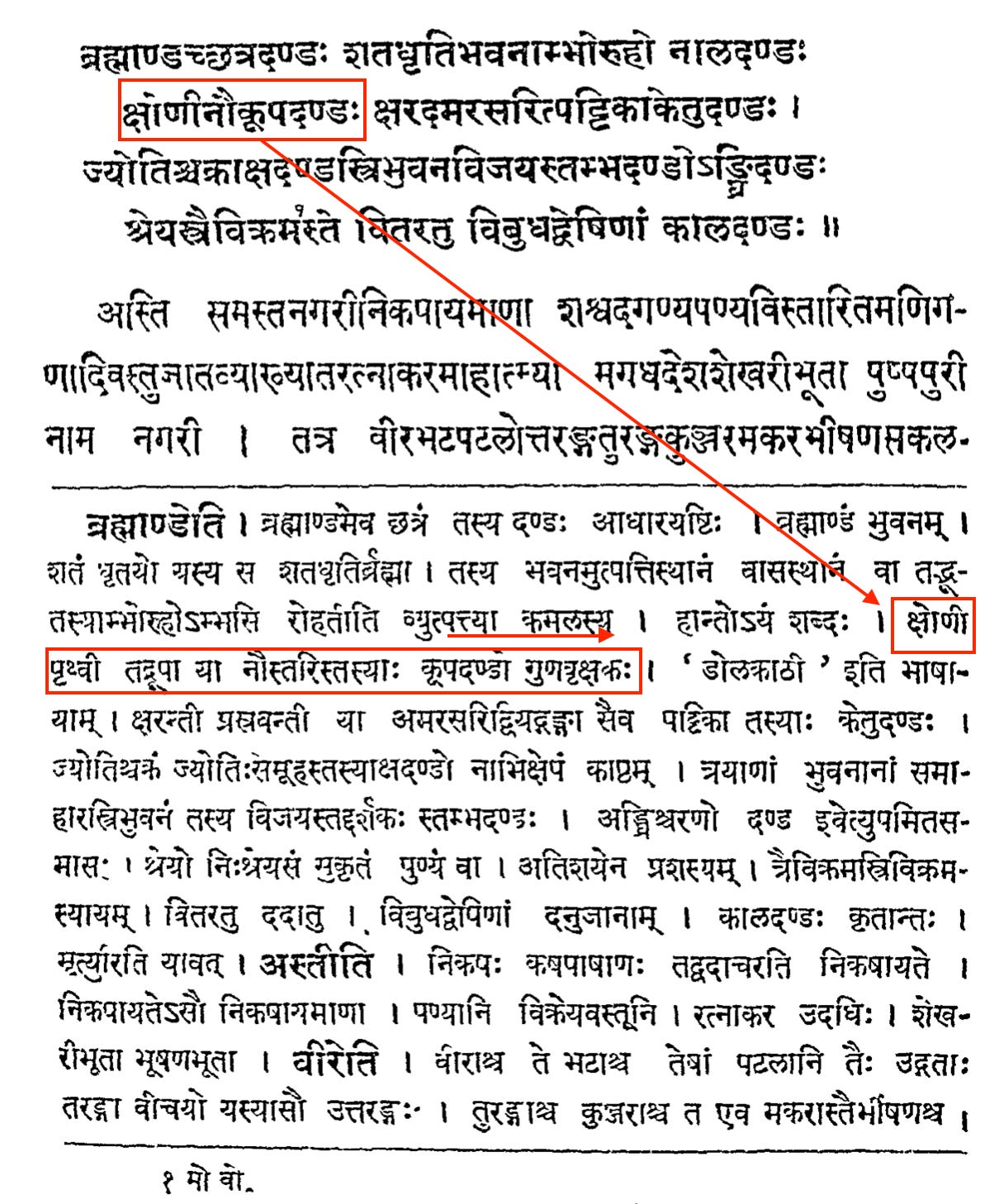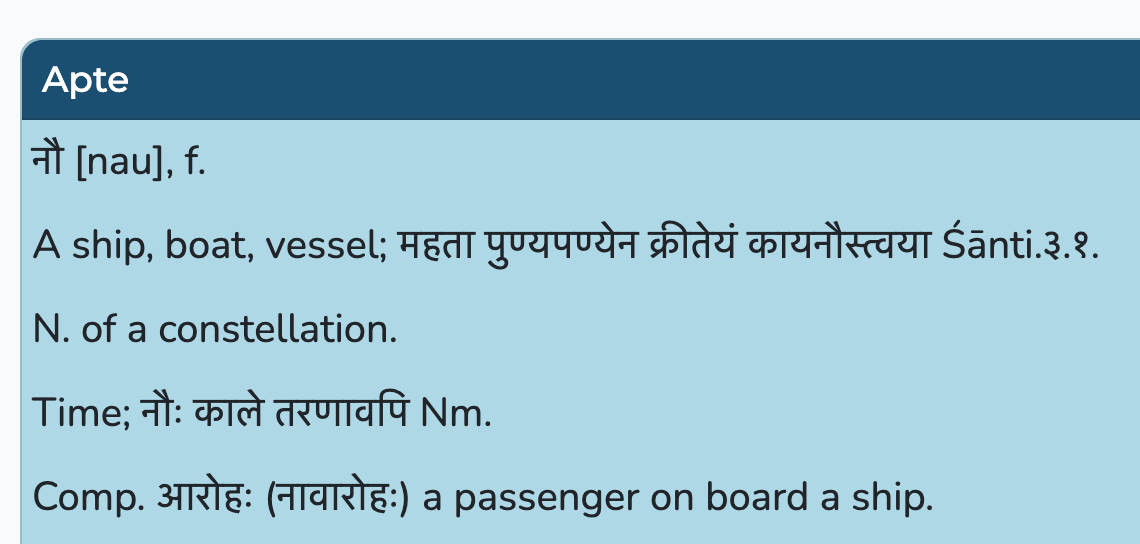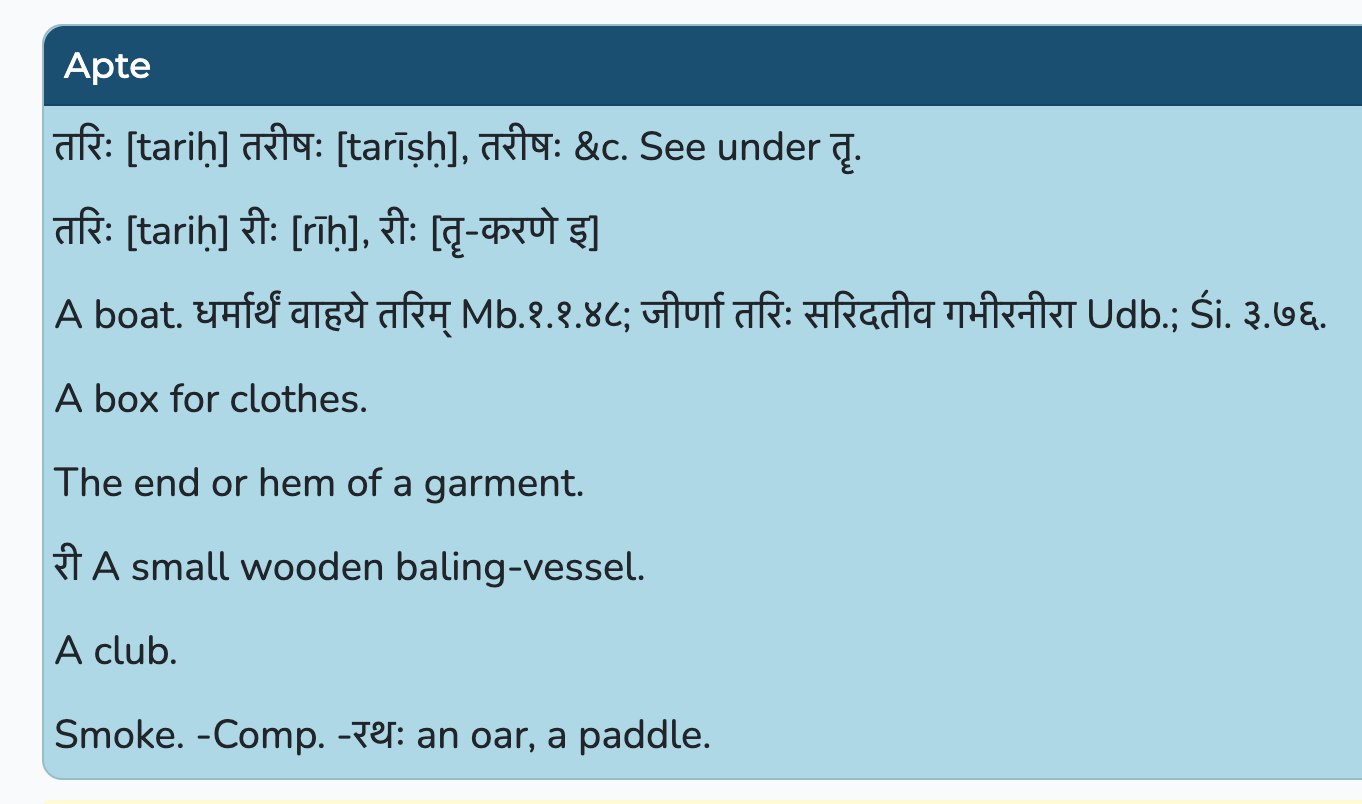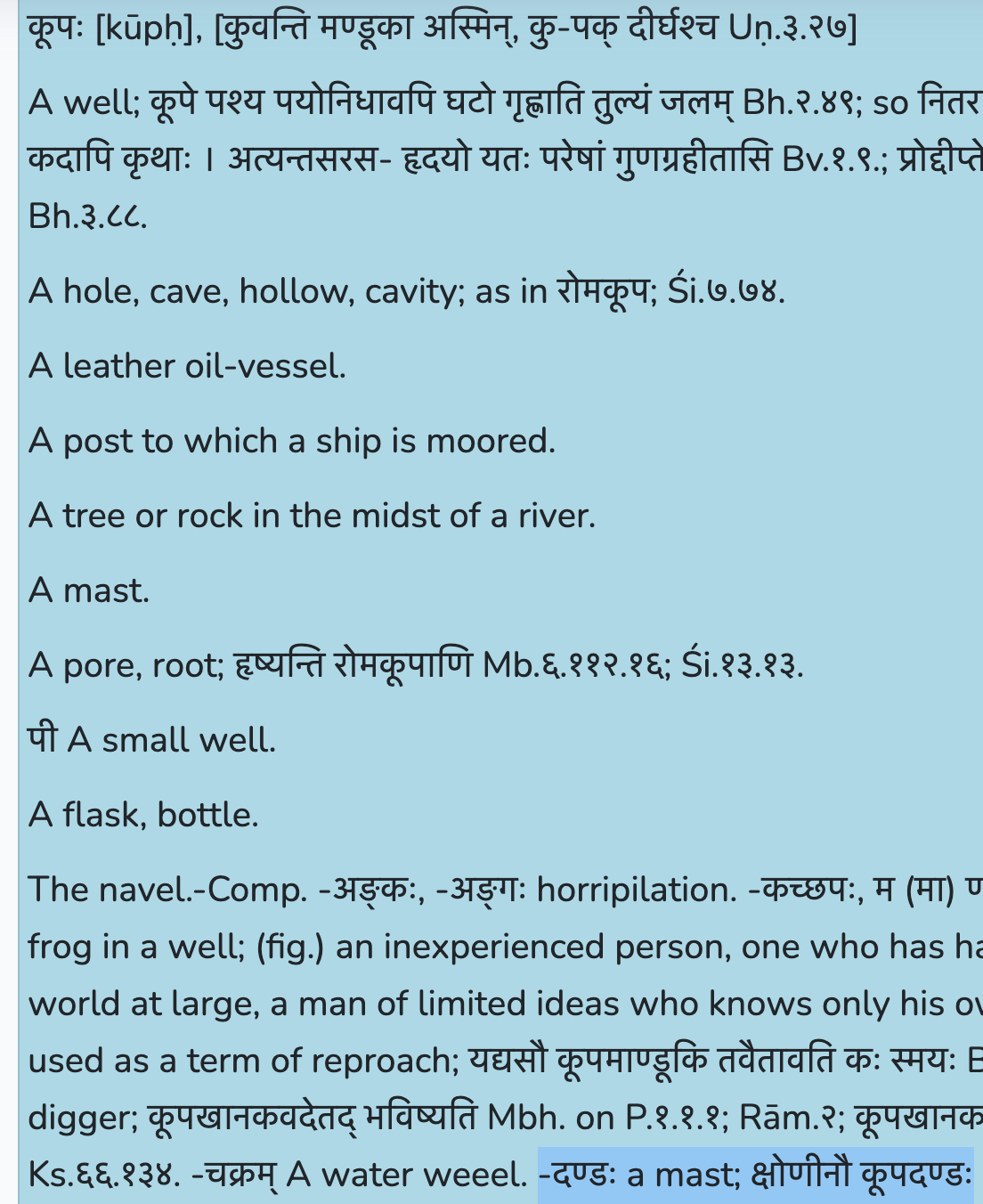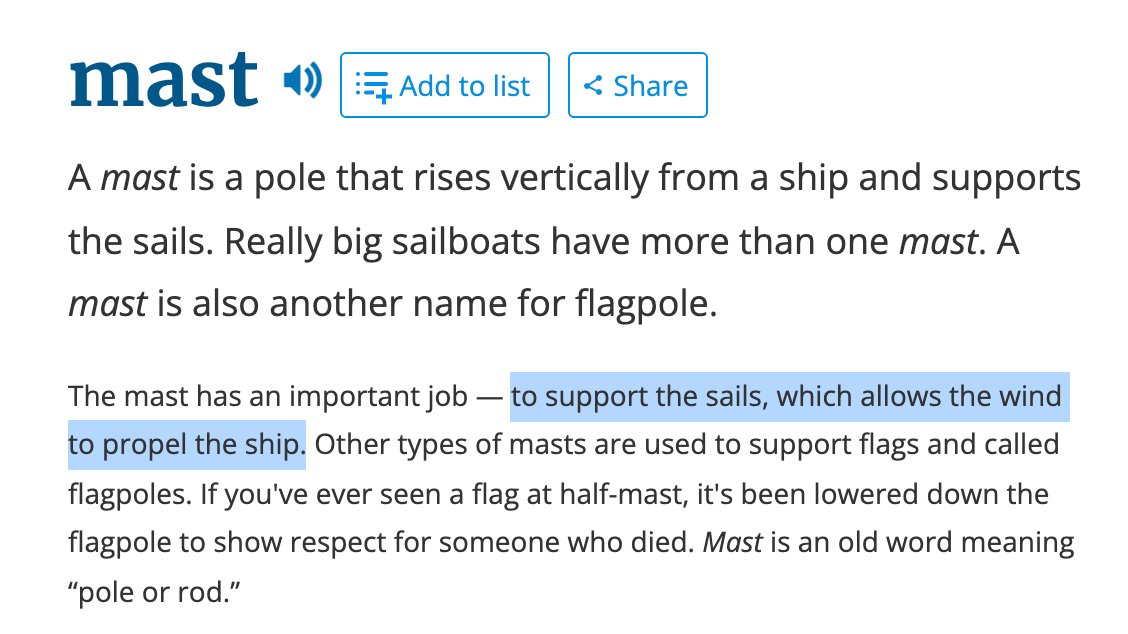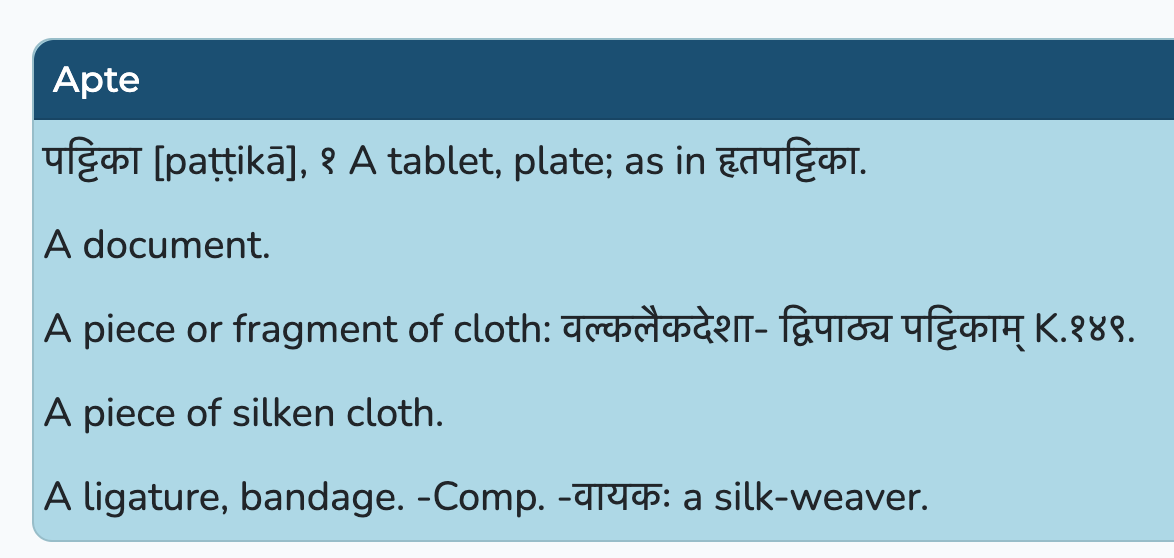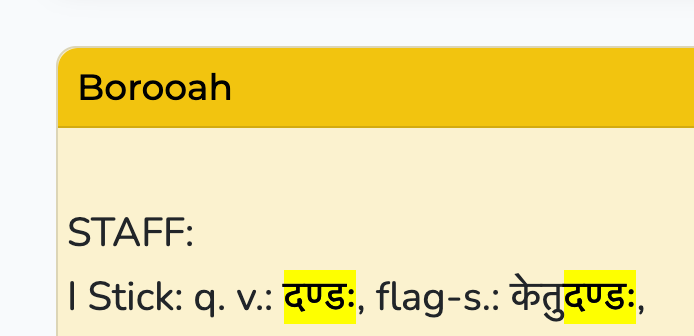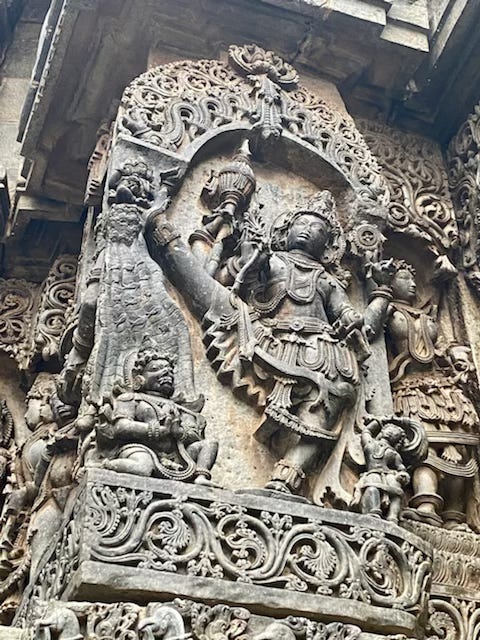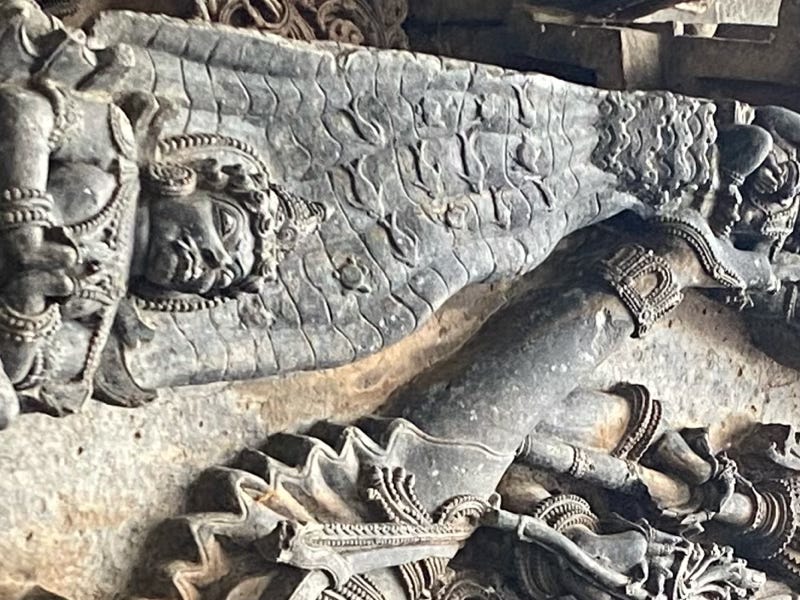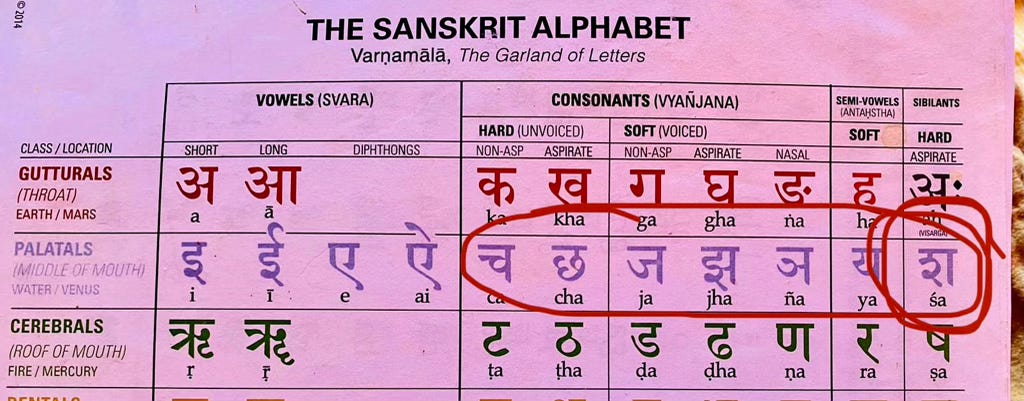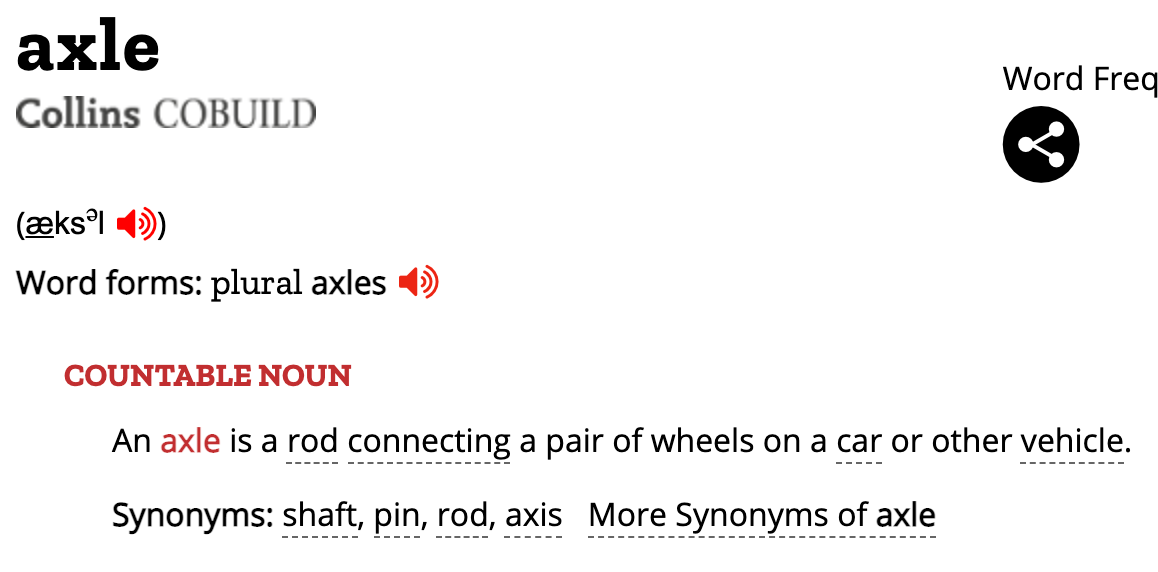A Look at Sanskrit Literature: Daśakumāracaritam
The creativity of Sanskrit poets is truly astounding!
In my MA Sanskrit Studies program, we are currently reading दशकुमारचरितम् (Daśakumāracaritam). In Sanskrit Literature, the text opens up with a मङ्गलाचरण (Maṅgalācaraṇa) - a shloka that praises the author’s Deity of choice in a creative poetic way.
These shlokas are extra difficult to understand as they are extremely creative, requiring both a deep knowledge of Indian culture and a rich imagination. Our teacher, Dr. Arjuna has kindly spent a lot of time answering all my questions about the details on how to understand this shloka.
Additionally, I was lucky enough to go on a deep cultural road trip from Udupi to Hampi with Dr. Satyajith, stopping at the mind-blowing Channakeshwara and the Hoysaleswara / Halebidu Temples, where I could experience this shloka come to life in unbelievable 3-D carvings. In this blog post, I will share what I learned so others can understand the rich complexity and imagination that is encaptured by ancient Sanskrit authors.
You can follow along with the text here:
The Shloka
ब्रह्माण्डच्छत्रदण्डः शतधृतिभवनाम्भोरुहो नालदण्डः
क्षोणीनौकूपदण्डः क्षरदमरसरित्पट्टिकाकेतुदण्डः ।
ज्योतिश्चक्राक्षदण्डस्त्रिभुवनविजयस्तम्भदण्डोऽङ्घ्रिदण्डः
श्रेयस्त्रैविक्रमस्ते वितरतु विबुधद्वेषिणां कालदण्डः ।।
brahmāṇḍacchatradaṇḍaḥ śatadhṛtibhavanāmbhoruho nāladaṇdaḥ
kṣoṇīnaukūpadaṇḍaḥ kṣaradamarasaritpaṭṭikāketudaṇdaḥ ।
jyotiścakrākṣadaṇḍastribhuvanavijayastambhadaṇḍo'ṅghridaṇdaḥ
śreyastraivikramaste vitaratu vibudhadveṣiṇāṃ kāladaṇḍaḥ ।।
An Umbrella and a Lotus
The first line of this shloka is:
ब्रह्माण्डच्छत्रदण्डः शतधृतिभवनाम्भोरुहो नालदण्डः
To break it down, we’ll start with ब्रह्माण्डच्छत्रदण्डः. The first thing to do is to look into the commentary:
We can now easily split ब्रह्माण्डच्छत्रदण्डः into ब्रह्माण्ड-छत्र-दण्डः. According to the commentary, this Samasa splits into ब्रह्माण्डम् एव छत्रं तस्य दण्डः आधारयष्टिः.
ब्रह्माण्ड refers to the whole universe.
Since the छत्रं or umbrella is referred to, culturally we would connect this to Vamana, an avatar of Vishnu as a dwarf who holds an umbrella:
So now we can refer that this Maṅgalācaraṇa shloka is praising Vamana as the Deity of choice for the author.
It is further clarified that छत्रं तस्य दण्डः - the umbrella is his दण्ड (daṇḍaḥ), or stick loosely translated. In Hindu tradition, when a child reaches the Brahmanchari stage of life at the age of 7 - 11, he is given a दण्ड, which represents his power as a Brahmin that he carries with him all his life. So this shloka plays a lot with this concept of दण्द! Notice the number of times it is used!
आधारयष्टिः in the commentary refers to the word आधार in the dictionary, meaning support.
So this first Samasa ब्रह्माण्डच्छत्रदण्डः means:
His (Vamana’s) Umbrella, which acts as his Daṇḍa, supports the entire universe.
शतधृतिभवनाम्भोरुहो नालदण्डः
Following the same process, we can split this Samasa and Sandhi by looking at the commentary:
शत-धृति-भवन-अम्भोरुहः नाल-दण्डः
शतं usually means 100, or some other large number. But according to the commentary शतधृतिः ब्रह्मा - शतधृतिः is another name for Brahma, the creator of the universe. Looking closer, another definition of शतं is Vishnu. धृति means to hold. So Brahma is one who is held by Vishnu. This invokes the famous image of Brahma emerging out of Vishnu’s naval:
This shows the greatness of Vishnu - he is the creator of the creator!
शतधृति - Brahma, the creator of the universe
The next words are भवन-अम्भोरुहः
भवन = house
अम्भोरुहः = lotus
As we can see from the above image, Brahma’s house is the Lotus. According to the commentary: तस्य भवनम् उत्पत्ति स्थानं वास-स्थानं वा तद्-भूतस्य-आम्भोरुहः अम्भसि रोहति इति व्युत्पत्त्या कमलसय.
तस्य भवनम् - his (Brahmas) house
उत्पत्ति स्थानं - birth place
वास-स्थानं - a place of living
भवन refers to Brahma’s birthplace where he lives
तद्-भूतस्य - that exists
आम्भोरुहः = अम्भसि रोहति इति व्युत्पत्त्या कमलसय - the etymology of the word आम्भोरुहः, which refers to कमलसय, a lotus, is अम्भसि रोहति - that which rises out of water. Further, the word आम्भोरुहः is हान्तः अयं शब्दः, it ends with the letter ह्, with the root Pratipadika being अम्भोरुह्.
आम्भोरुहः - that house exists in the Lotus
Brahma’s birthplace where he lives that exists in the Lotus
नाल-दण्डः - the stalk that comes out of Vishnu’s navel, of which Brahma’s Lotus is born, is compared to a दण्ड.
Putting it all together, the commentary is saying that:
Vishnu’s navel is the origin of the Lotus in which Brahma is born and resides, with the stalk of the lotus as his दण्ड.
Earth Boat Mast
The word क्षोणीनौकूपदण्डः (kṣoṇīnaukūpadaṇḍaḥ) is a Samasa, a combination of different words of no declensions:
क्षोणी-नौ-कूप-दण्डः (kṣoṇī-nau-kūpa-daṇḍaḥ)
When you look up each of these words in the dictionary, they have many meanings! For example, क्षोणी means:
So to understand which meaning fits, it is required to look into the commentary.
Here, क्षोणी is defined as पृथ्वी. Looking up पृथ्वी in the dictionary, we also get a variety of meanings:
Between the two definitions, the word that intersects both क्षोणी and पृथ्वी is earth.
क्षोणी = Earth
The same process if followed for नौ :
According to the commentary, it says नौस्तरिस्तस्यः, which is a sandhi that splits into नौः तरिः तस्यः - looking up तरिः in the dictionary also yields several meanings:
Here, both नौः and तरिः have “boat” as the common definition.
नौः = Boat
Next, कूप and दण्दः would normally be seen as separate words. But, as per the commentary:
कूपदण्डः as one word means गुणवृक्षकः
कूपदण्ड does not show up in the dictionary directly. But when you look up कूप in the Apte dictionary, there will be a definition with -दण्ड as the suffix:
So now, it’s possible to see that कूपदण्डः means “a mast”. And in case, we cannot find it, the word गुणवृक्षक as per the commentary leaves no more doubt in this definition:
कूपदण्डः = a mast
So now we come to the conclusion that this Samasa:
क्षोणी-नौ-कूपदण्डः = Earth-Boat-Mast
So what does this mean?!!! This is where that cultural understanding and imagination comes in…
This shloka is describing a god, in this case, Vamana, an incarnation of Vishnu. So now we know there is a 4th unwritten word in this Samasa - Vamana as the subject.
Next, you think of the connection between Earth and Boat. Boat and Mast are clearly connected. Since I’m not familiar with masts, I googled it and found the following information:
The job of the mast is to propel or move the boat. We can now connect that Earth also moves. So now, we can interpret this shloka to mean:
Just like the Mast moves the Boat, so does Vamana (God) moves the Earth.
Running Ganga Cloth Flagstaff
क्षरदमरसरित्पट्टिकाकेतुदण्डः is a Samasa that is split as follows:
क्षरत्-अमर-सरित्-पट्टिका-केतु-दण्डः
According to the dictionary, क्षरत् means “trickling, oozing, running”. As per the commentary, क्षरन्ती प्रस्रवन्ती
प्रस्रवन्ती is a verb - so to look it up in the dictionary, we have to first figure out its root. Using the Samsadhani Morphological tool, we find that the root is प्रस्रु. According to the dictionary:
So from both क्षरत् and प्रस्रु meaning, we can connect this to the action of water oozing or running.
क्षरत् = oozing, running (water)
Next, we have the word अमर. But looking at the dictionary, it is clear that it should be combined with सरित्, अमर-सरित्.
This splits into अमर-सरित्-वियत्-गङ्गा. वियत् means heavenly and गङ्गा refers to the Ganga river.
अमर-सरित् = the heavenly Ganga river
So now we know that the Ganges river is running/oozing/flowing.
Next is पट्टिका - when looking it up we get:
Now again, the imagination comes in. Should पट्टिका be a tablet, plate, or a piece of cloth? We know that the previous words are talking about the river Ganga flowing. So tablet and plate do not fit. What we can imagine is a fast-flowing river and how it would look white as a piece of cloth!

पट्टिका - a piece of cloth
Next, in the commentary, we see that केतुदण्डः is one word, not separated. But it has no explanation. Looking it up in the dictionary, we find one meaning of this word as flag-staff:
केतुदण्डः= flag-staff
Ok - so now we have:
क्षरत्-अमरसरित्-पट्टिका-केतुदण्डः = Running-Ganga-Cloth-Flagstaff
Back to imagination… Again, we know that this shloka is referring to Vamana. How is Vamana related to the Ganga? In Vamana’s story, when he becomes large (taking the Trivikrama form) and takes three steps, his second step goes into the Brahmanda (the universe), where his toe-nail cracks the vessel that is holding the Ganga, making the Ganga flow. This is the depiction of the event I saw at the Channakeshwara temple:
If you reverse the image, you will be able to see that the Ganga looks like a flag, with Trivikrama’s foot as the flagstaff…
Vamana acts as the Flagstaff, with heavenly running Ganga as the white flag.
A Stick of Light
The whole long line ज्योतिश्चक्राक्षदण्डस्त्रिभुवनविजयस्तम्भदण्डोऽङ्घ्रिदण्डः can be split into 3 parts:
ज्योतिस्- चक्र-अक्ष-दण्डः
Here, the word ज्योतिस् is tricky. It might look like a Visarga, but there is a special rule. When स् is followed by च, छ, ज, झ, इत् it is replaced by a श्
In the same way, when स् is followed by ट, ठ, ड्, ढ, it is replaced by ष्
So in this case, ज्योतिस् is the Pratipadika used.
According to the commentary:
ज्योतिश्चक्र means ज्योइतिः समूहः, a collection of light. In other words, here चक्र does not mean the common “wheel” definition, but the “A multitude, troop, group” definition.
ज्योतिश्चक्र = a multitude of light
Next, the commentary uses the combined word अक्षदण्डः - looking up अक्ष in the Apte dictionary, we find that अक्ष + the दण्डः post-fix means “axel-pole”. I had to Google what that is…
So an axle pole is something that connects two things (like the wheels of a car).
अक्षदण्डः - axle pole
The commentary then says नाभिक्षेपं काष्ठम्. नाभिक्षेपं means something that is kept close to the stomach region. काष्ठम् means stick.
Now here is where the cultural knowledge needs to come in…
There is a ritual for a Bhramachari where he will create fire during different parts of the day. To keep the fire with him symbolically, he will put a stick into the fire, and carry that stick around him during the day, as if connected to the fire via an axle. In the case of Vamana, his stick maintains a multitude of light!
Vamana’s stick connects to a multitude of light.
त्रिभुवन-विजय-स्तम्भ-दण्डः
त्रिभुवन describes the three worlds. Earth, Heaven, and Underworld are translated very loosely.
विजय = victory
According to the commentary, it says:
त्रयाणां भुवनानां समाहारः त्रिभुवनं तस्य विजयः तत् दर्शकः - this means that Vamana is “one who shows the victory of the three worlds together.”
स्तम्भदण्डः - स्तम्भदण्डः here is not in the dictionary. But we can get the meaning of it from the next word:
अङ्घ्रि-दण्डः
The world अङ्घ्रि means foot in the dictionary. This is confirmed by the commentary:
अङ्घ्रिः चरणः - which gives the meaning of अङ्घ्रिः as चरणः, also meaning foot.
Finally, the commentary points out the word अङ्घ्रिदण्ड here is a special type of Samasa. This Samasa is comparing the स्तम्भदण्ड to अङ्घ्रिदण्ड. The word स्तम्भ means pillar or pole.
So the definiton of ज्योतिश्चक्राक्षदण्डस्त्रिभुवनविजयस्तम्भदण्डोऽङ्घ्रिदण्डः is:
Vamana’s foot is like a pole that is showing his victory over all the three worlds.
The Desire-Fulfilling or Death Stick
The final line of this shloka is: श्रेयस्त्रैविक्रमस्ते वितरतु विबुधद्वेषिणां कालदण्डः
श्रेयस्त्रैविक्रमस्ते वितरतु
Here, we can break up the words into:
श्रेयः त्रैविक्रमः ते वितरतु
As per the commentary:
श्रेयः can mean two things: निःश्रेअसम् or (वा) सुकृतं पुण्यम्. निःश्रेअसम् means that which is most desirable. सुकृतं पुण्यम् means good deeds. अतिशयेन प्रशस्यम् is where the commentary encourages us to choose the definition that we think is excessively suitable!
श्रेयः - that which is most desirable or good deeds.
त्रैविक्रमः refers to त्रिविक्रमस्य अयम् - That (अयम्) which belongs to Trivikrama. Trivikrama is the form of Vamana who takes the three steps in the story. So here, it is referring to an item that belongs to Vamana. Since the shloka has been referring to Vamana’s Daṇḍa (stick), we can infer that the object here is Trivikrama’s Daṇḍa.
त्रैविक्रमः - Trivikrama’s Daṇḍa
वितरतु means ददातु or the command/request tense of the verb to give. So we can translate it as “must give/distribute”.
वितरतु - must give/distribute
The word ते here is tricky. Usually, we think of ते to mean “they”. But here, it is referring to the चतुर्थी विभक्ति एकवचनम् form of the pronoun युष्मद्, meaning “to you”.
ते - to you
Putting it all together, श्रेयः त्रैविक्रमः ते वितरतु means:
May Vamana give what is most desirable/good deeds to you.
विबुधद्वेषिणां कालदण्डः
In contrast, कालदण्डः or stick of death! should be given to those who are bad. Here the word काल, or time, is used to indicate death as a function of time - when you die, your time is up! As per the commentary, कालदण्डः is कृतान्त, another name for Yama, the god of Death.
In this case, विबुध refers to the दनुजानाम्, the sons of Prajapati from a woman named Danu who were born to do bad things in the world.
द्वेषिणां refers to those who hate God.
So to those who are bad, Vamana should give the stick of death!
Putting it All Together
Finally, we can see the genius of the poet of this Maṅgalācaraṇa praising Vishnu, mostly in the avatar of Vamana, by cleverly using the word दण्ड in every instance!
The final translation will be something like:
Vamana’s Umbrella, which acts as his दण्ड, supports the entire universe.
Vishnu’s naval is the origin of the Lotus in which Brahma is born and resides, with the stalk of the lotus as his दण्ड.
Just like the कूपदण्ड (Mast) moves the Boat, so does Vamana (God) moves the Earth.
Vamana is the केतुदण्डः (Flagstaff), on which the Ganga is the flag.
Vamana is the अक्षदण्डः (axle-pole) which connects to a multitude of light.
Vamana’s अङ्घ्रिदण्ड (foot) is like a pole that is showing his victory over all the three worlds.
May Trivikrama’s दण्डः gives what is most desireable / good deeds to you.
May Trivikrama’s दण्ड be the कालदण्डः (stick of death) to those who are evil.



